Abstract
Initial studies suggested that major histocompatibility complex class I-restricted viral epitopes could be predicted by the presence of particular residues termed anchors. However, recent studies showed that nonanchor positions of the epitopes are also significant for class I binding and recognition by cytotoxic T lymphocytes (CTLs). We investigated if changing nonanchor amino acids could increase class I affinity, complex stability, and T-cell recognition of a natural viral epitope. This concept was tested by using the HLA-A 0201-restricted human immunodeficiency virus type 1 epitope from reverse transcriptase (pol). Position 1 (P1) amino acid substitutions were emphasized because P1 alterations may not alter the T-cell receptor interaction. The peptide with the P1 substitution of tyrosine for isoleucine (I1Y) showed a binding affinity for HLA-A 0201 similar to that of the wild-type pol peptide in a cell lysate assembly assay. Surprisingly, I1Y significantly increased the HLA-A 0201-peptide complex stability at the cell surface. I1Y sensitized HLA-A 0201-expressing target cells for wild-type pol-specific CTL lysis as well as wild-type pol. Peripheral blood lymphocytes from three HLA-A2 HIV-seropositive individuals were stimulated in vitro with I1Y and wild-type pol. I1Y stimulated a higher wild-type pol-specific CTL response than wild-type pol in all three donors. Thus, I1Y may be an "improved" epitope for use as a CTL-based human immunodeficiency virus vaccine component. The design of improved epitopes has important ramifications for prophylaxis and therapeutic vaccine development.
Full text
PDF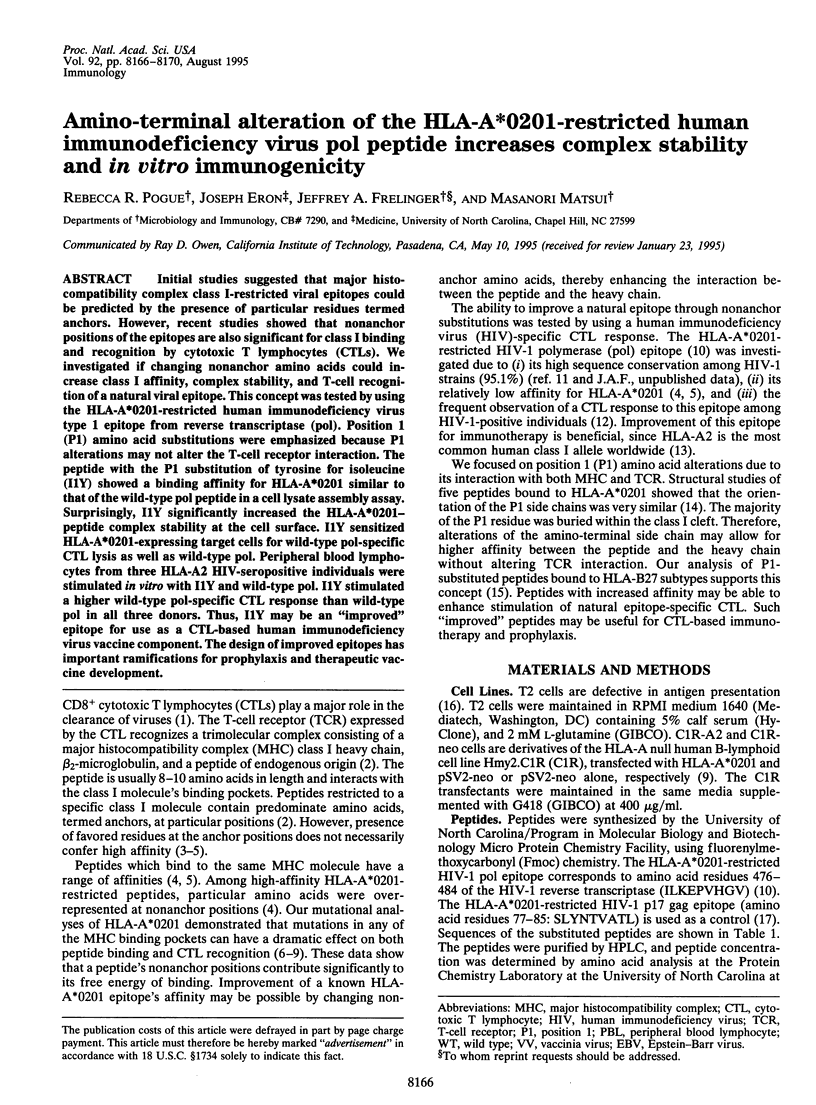
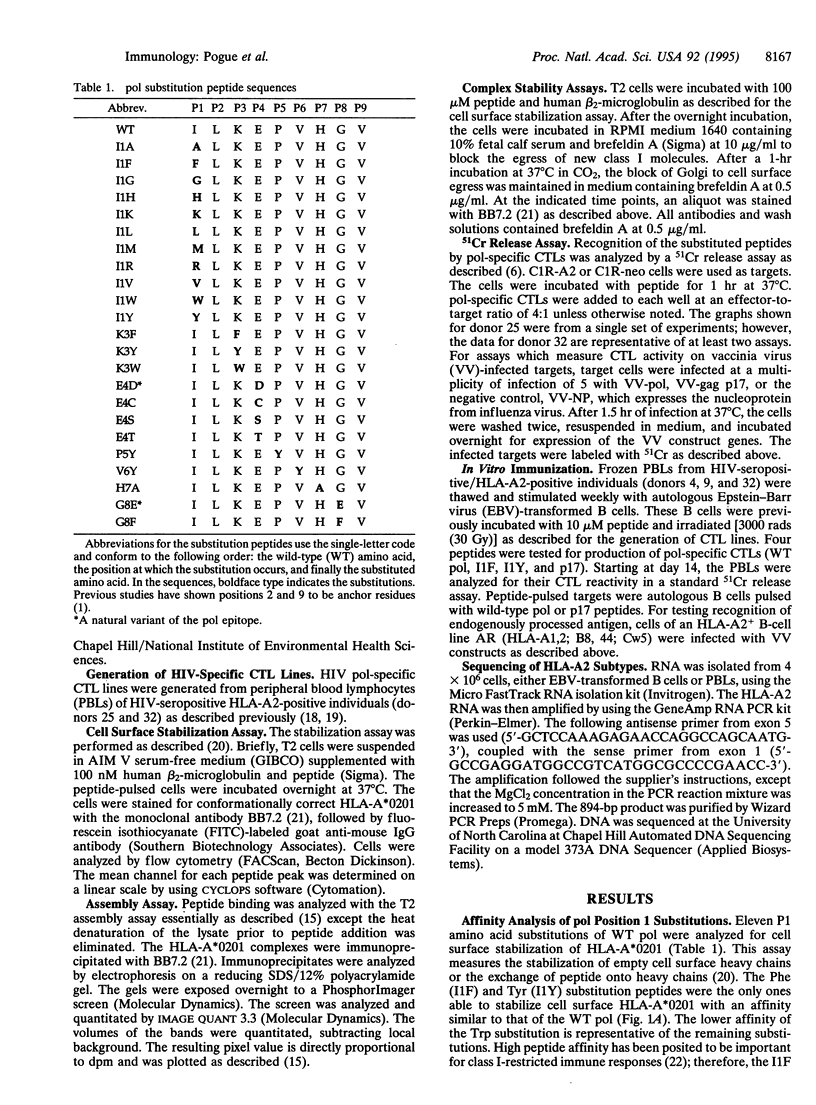
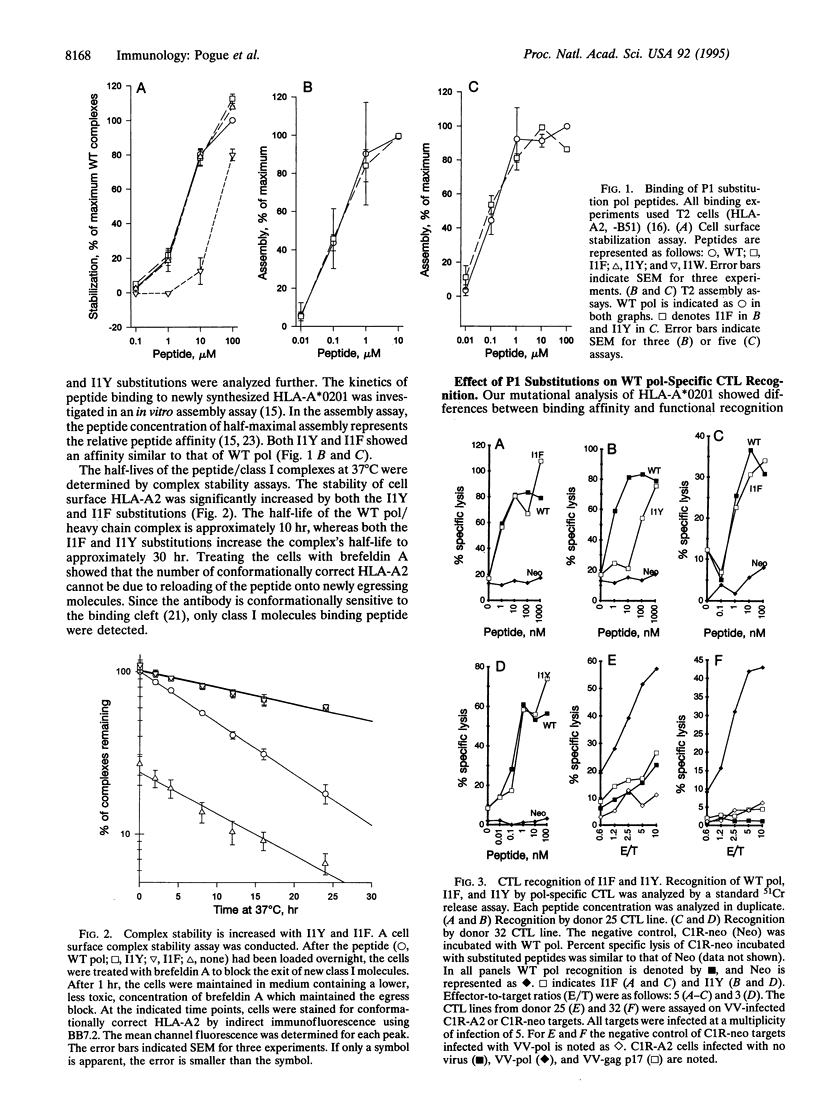
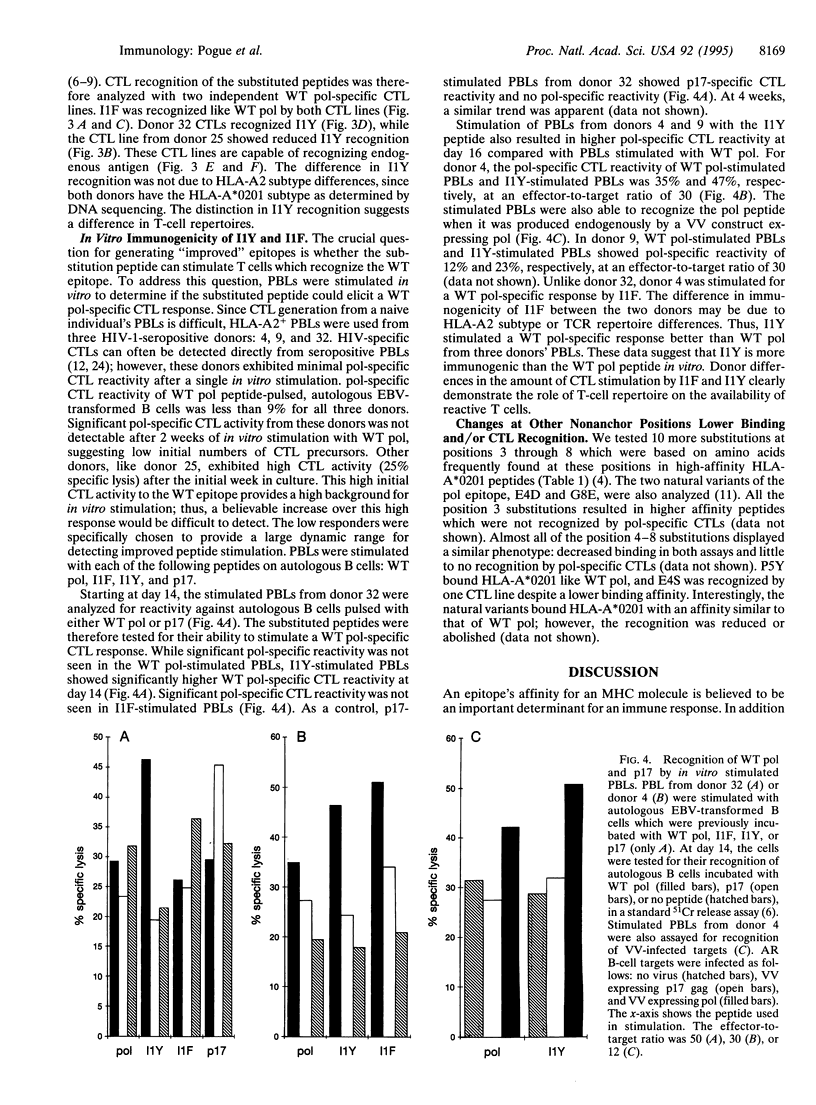
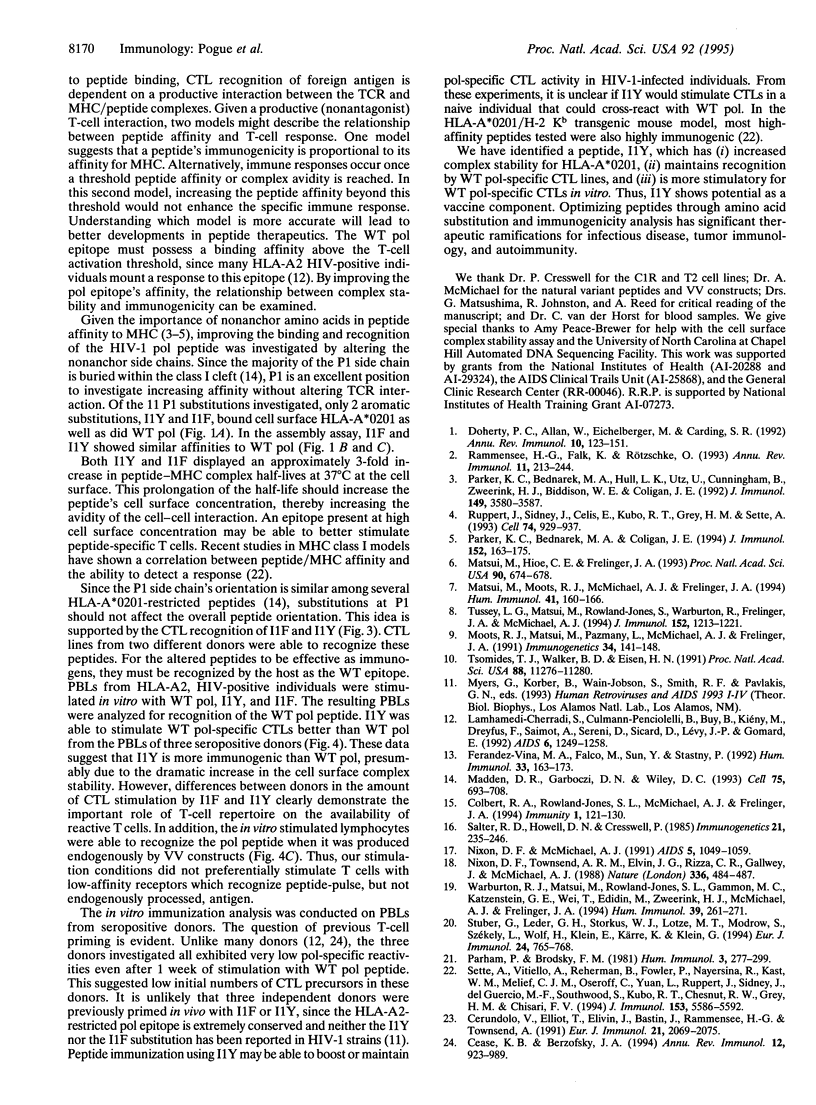
Selected References
These references are in PubMed. This may not be the complete list of references from this article.
- Cease K. B., Berzofsky J. A. Toward a vaccine for AIDS: the emergence of immunobiology-based vaccine development. Annu Rev Immunol. 1994;12:923–989. doi: 10.1146/annurev.iy.12.040194.004423. [DOI] [PubMed] [Google Scholar]
- Cerundolo V., Elliott T., Elvin J., Bastin J., Rammensee H. G., Townsend A. The binding affinity and dissociation rates of peptides for class I major histocompatibility complex molecules. Eur J Immunol. 1991 Sep;21(9):2069–2075. doi: 10.1002/eji.1830210915. [DOI] [PubMed] [Google Scholar]
- Colbert R. A., Rowland-Jones S. L., McMichael A. J., Frelinger J. A. Differences in peptide presentation between B27 subtypes: the importance of the P1 side chain in maintaining high affinity peptide binding to B*2703. Immunity. 1994 May;1(2):121–130. doi: 10.1016/1074-7613(94)90105-8. [DOI] [PubMed] [Google Scholar]
- Doherty P. C., Allan W., Eichelberger M., Carding S. R. Roles of alpha beta and gamma delta T cell subsets in viral immunity. Annu Rev Immunol. 1992;10:123–151. doi: 10.1146/annurev.iy.10.040192.001011. [DOI] [PubMed] [Google Scholar]
- Fernandez-Viña M. A., Falco M., Sun Y., Stastny P. DNA typing for HLA class I alleles: I. Subsets of HLA-A2 and of -A28. Hum Immunol. 1992 Mar;33(3):163–173. doi: 10.1016/0198-8859(92)90068-x. [DOI] [PubMed] [Google Scholar]
- Lamhamedi-Cherradi S., Culmann-Penciolelli B., Guy B., Kiény M. P., Dreyfus F., Saimot A. G., Sereni D., Sicard D., Lévy J. P., Gomard E. Qualitative and quantitative analysis of human cytotoxic T-lymphocyte responses to HIV-1 proteins. AIDS. 1992 Nov;6(11):1249–1258. doi: 10.1097/00002030-199211000-00002. [DOI] [PubMed] [Google Scholar]
- Madden D. R., Garboczi D. N., Wiley D. C. The antigenic identity of peptide-MHC complexes: a comparison of the conformations of five viral peptides presented by HLA-A2. Cell. 1993 Nov 19;75(4):693–708. doi: 10.1016/0092-8674(93)90490-h. [DOI] [PubMed] [Google Scholar]
- Matsui M., Hioe C. E., Frelinger J. A. Roles of the six peptide-binding pockets of the HLA-A2 molecule in allorecognition by human cytotoxic T-cell clones. Proc Natl Acad Sci U S A. 1993 Jan 15;90(2):674–678. doi: 10.1073/pnas.90.2.674. [DOI] [PMC free article] [PubMed] [Google Scholar]
- Matsui M., Moots R. J., McMichael A. J., Frelinger J. A. Significance of the six peptide-binding pockets of HLA-A2.1 in influenza A matrix peptide-specific cytotoxic T-lymphocyte reactivity. Hum Immunol. 1994 Oct;41(2):160–166. doi: 10.1016/0198-8859(94)90010-8. [DOI] [PubMed] [Google Scholar]
- Moots R. J., Matsui M., Pazmany L., McMichael A. J., Frelinger J. A. A cluster of mutations in HLA-A2 alpha 2 helix abolishes peptide recognition by T cells. Immunogenetics. 1991;34(3):141–148. doi: 10.1007/BF00205816. [DOI] [PubMed] [Google Scholar]
- Nixon D. F., McMichael A. J. Cytotoxic T-cell recognition of HIV proteins and peptides. AIDS. 1991 Sep;5(9):1049–1059. [PubMed] [Google Scholar]
- Nixon D. F., Townsend A. R., Elvin J. G., Rizza C. R., Gallwey J., McMichael A. J. HIV-1 gag-specific cytotoxic T lymphocytes defined with recombinant vaccinia virus and synthetic peptides. Nature. 1988 Dec 1;336(6198):484–487. doi: 10.1038/336484a0. [DOI] [PubMed] [Google Scholar]
- Parham P., Brodsky F. M. Partial purification and some properties of BB7.2. A cytotoxic monoclonal antibody with specificity for HLA-A2 and a variant of HLA-A28. Hum Immunol. 1981 Dec;3(4):277–299. doi: 10.1016/0198-8859(81)90065-3. [DOI] [PubMed] [Google Scholar]
- Parker K. C., Bednarek M. A., Coligan J. E. Scheme for ranking potential HLA-A2 binding peptides based on independent binding of individual peptide side-chains. J Immunol. 1994 Jan 1;152(1):163–175. [PubMed] [Google Scholar]
- Parker K. C., Bednarek M. A., Hull L. K., Utz U., Cunningham B., Zweerink H. J., Biddison W. E., Coligan J. E. Sequence motifs important for peptide binding to the human MHC class I molecule, HLA-A2. J Immunol. 1992 Dec 1;149(11):3580–3587. [PubMed] [Google Scholar]
- Rammensee H. G., Falk K., Rötzschke O. Peptides naturally presented by MHC class I molecules. Annu Rev Immunol. 1993;11:213–244. doi: 10.1146/annurev.iy.11.040193.001241. [DOI] [PubMed] [Google Scholar]
- Ruppert J., Sidney J., Celis E., Kubo R. T., Grey H. M., Sette A. Prominent role of secondary anchor residues in peptide binding to HLA-A2.1 molecules. Cell. 1993 Sep 10;74(5):929–937. doi: 10.1016/0092-8674(93)90472-3. [DOI] [PubMed] [Google Scholar]
- Salter R. D., Howell D. N., Cresswell P. Genes regulating HLA class I antigen expression in T-B lymphoblast hybrids. Immunogenetics. 1985;21(3):235–246. doi: 10.1007/BF00375376. [DOI] [PubMed] [Google Scholar]
- Sette A., Vitiello A., Reherman B., Fowler P., Nayersina R., Kast W. M., Melief C. J., Oseroff C., Yuan L., Ruppert J. The relationship between class I binding affinity and immunogenicity of potential cytotoxic T cell epitopes. J Immunol. 1994 Dec 15;153(12):5586–5592. [PubMed] [Google Scholar]
- Stuber G., Leder G. H., Storkus W. T., Lotze M. T., Modrow S., Székely L., Wolf H., Klein E., Kärre K., Klein G. Identification of wild-type and mutant p53 peptides binding to HLA-A2 assessed by a peptide loading-deficient cell line assay and a novel major histocompatibility complex class I peptide binding assay. Eur J Immunol. 1994 Mar;24(3):765–768. doi: 10.1002/eji.1830240341. [DOI] [PubMed] [Google Scholar]
- Tsomides T. J., Walker B. D., Eisen H. N. An optimal viral peptide recognized by CD8+ T cells binds very tightly to the restricting class I major histocompatibility complex protein on intact cells but not to the purified class I protein. Proc Natl Acad Sci U S A. 1991 Dec 15;88(24):11276–11280. doi: 10.1073/pnas.88.24.11276. [DOI] [PMC free article] [PubMed] [Google Scholar]
- Tussey L. G., Matsui M., Rowland-Jones S., Warburton R., Frelinger J. A., McMichael A. Analysis of mutant HLA-A2 molecules. Differential effects on peptide binding and CTL recognition. J Immunol. 1994 Feb 1;152(3):1213–1221. [PubMed] [Google Scholar]
- Warburton R. J., Matsui M., Rowland-Jones S. L., Gammon M. C., Katzenstein G. E., Wei T., Edidin M., Zweerink H. J., McMichael A. J., Frelinger J. A. Mutation of the alpha 2 domain disulfide bridge of the class I molecule HLA-A*0201. Effect on maturation and peptide presentation. Hum Immunol. 1994 Apr;39(4):261–271. doi: 10.1016/0198-8859(94)90269-0. [DOI] [PubMed] [Google Scholar]


